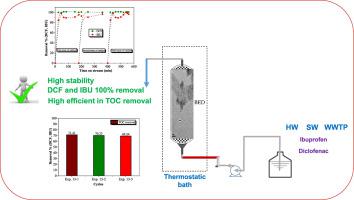Journal of Environmental Management ( IF 8.0 ) Pub Date : 2021-01-05 , DOI: 10.1016/j.jenvman.2020.111913 Y. Huaccallo-Aguilar , J.L. Diaz de Tuesta , S. Álvarez-Torrellas , H.T. Gomes , M. Larriba , G. Ovejero , J. García

|
This research has been focused on the removal of two anti-inflammatory drugs, diclofenac (DCF) and ibuprofen (IBU), by a continuous catalytic wet peroxide oxidation (CWPO) process using a lab-synthesized nanomagnetic catalyst (Fe3O4/MWCNTs). The central composite rotatable design (CCRD) method was used to study the effect of DCF and IBU concentration (expressed as theoretical oxygen demand (ThOD) between 0 and 52.5 mg L−1) and of the feed stream pH (from 3 to 7) on the removal of total organic carbon (TOC) and the concentration of aromatic compounds (Arm) and total phenolic compounds (TP) by CWPO. It could be observed that DCF was preferably removed from the DCF-IBU aqueous mixture at pH values ranging from 3 to 5. In addition, feed stream pH had a significant effect on the pollutants removal, as well as on TOC, TP and aromatic compounds removal, observing an increasing in the pollutants degradation when feed stream pH decreased from 7 to 3. Quadratic models predicted for response variable, such as TOC, TP and aromatic compounds removal, and their maximum model-predicted removal values were of 90.0, 80.2 and 90.0%, respectively. Finally, as a proof of concept, three environmentally-relevant aqueous matrices, spiked with DCF-IBU mixture, were treated. In this case, relatively high TOC degradation values were found after 20 h reaction time (ca. 57.7, 73.9 and 54.5% in surface water, WWTP effluent and hospital wastewater, respectively). This work deals the first study about DCF-IBU removal in aqueous solution by CWPO, as well as a continuous study using real wastewater that allow to extend the experimental results to a real scenario.
中文翻译:

在上流固定床反应器中使用磁铁矿基催化剂通过CWPO去除双氯芬酸和布洛芬的新见解
这项研究的重点是通过使用实验室合成的纳米磁性催化剂(Fe 3 O 4 / MWCNTs )的连续催化湿式过氧化物氧化(CWPO)工艺去除双氯芬酸(DCF)和布洛芬(IBU)两种消炎药。)。使用中央复合可旋转设计(CCRD)方法研究DCF和IBU浓度的影响(表示为0至52.5 mg L -1之间的理论需氧量(ThOD))和进料物流的pH值(从3至7)取决于通过CWPO除去总有机碳(TOC)以及芳香化合物(Arm)和总酚化合物(TP)的浓度。可以观察到,优选在pH值为3至5的情况下从DCF-IBU水性混合物中除去DCF。此外,进料流的pH值对污染物的去除以及TOC,TP和芳族化合物都有重要影响进料pH值从7降低到3时,污染物的降解增加。观察到预测响应变量的二次模型,例如TOC,TP和芳香族化合物的去除,其最大模型预测的去除值为90.0、80.2和。分别为90.0%。最后,作为概念证明,对掺有DCF-IBU混合物的三种与环境有关的水性基质进行了处理。在这种情况下,反应20小时后,TOC降解值相对较高(地表水,污水处理厂废水和医院废水中分别约为57.7、73.9和54.5%)。这项工作是关于通过CWPO去除水溶液中DCF-IBU的第一项研究,以及使用真实废水进行的连续研究,从而可以将实验结果扩展到真实场景。











































 京公网安备 11010802027423号
京公网安备 11010802027423号